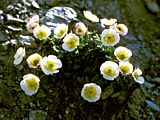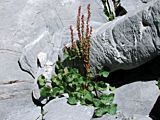Why are alpine plants richer in nutrients than lowland plants?
Why does a reduction of the season length lead to high nutrient concentrations?
This phenomenon is called "luxurious consumption".
Alpine plants of various climates produce few, short-lived and highly productive leaves in order to make maximum use of the short season. Often, the dry matter content is reduced and leaves become thicker (more cell layers).
Some alpine plant species, such as Ranunculus glacialis and Oxyria digyna may have concentrations of up to 5 % nitrogen in leaves, which means one third of their leaf dry matter is protein (5 times 6.25, the mean conversion factor of N to protein mass). Common concentrations in non-evergreen leaves are 2-3 % N.


